With the advent of “openers”, “bullpen days”, and avoidance of the dreaded “third time through the order”, recent seasons have seen a quickening of the already rapid decline in the average length of a pitcher’s start. Perhaps, though, there is reason to surmise that starts may begin lengthening soon. Find out why after the jump.
Here are the average lengths of a start for each season of the live ball era.
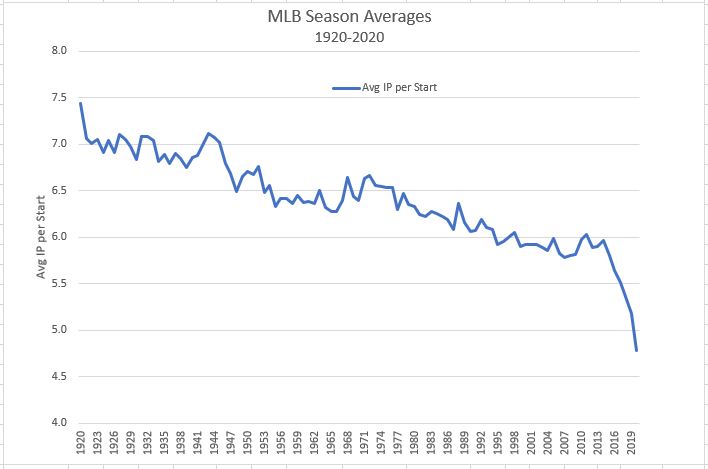
The trend in declining innings per start is well established and was fairly consistent throughout the live ball era, other than these few anomalies:
- Steep decline in IP per start in the transition from the dead ball era
- Rise in IP per start during World War II years, based primarily on economic considerations
- Rise in IP per start in the late 1960s (“second dead ball era”) and again in the mid-1970s (advent of the DH rule)
- Rise in IP per start in the early 2010s (end of “steroids era”)
- Rapid decline in IP per start beginning in 2015 (perfect storm of protecting or over-protecting high-value assets, heavy reliance on analytics, and maybe a juiced ball, whether intended or not)
That last bullet is an understatement. As shown in the chart, IP per start have fallen off a cliff since 2015, with a decline of at least 0.12 IP per start each season since. That trend will end in 2021, which is looking like it will finish in the 5.05 to 5.1 IP per start range, but that number will still be ~0.1 IP lower than in the last full length season in 2019. For a sense of how rapidly start length has fallen recently compared to the past, consider the table below.
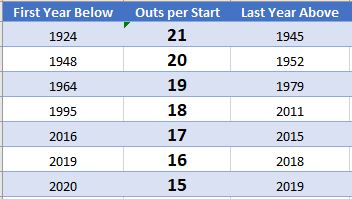
The years listed under “Last Year Above” are subject to change (especially years since 2011), but suffice to say that it took 71 years (1924 to 1995) for the average start to drop from below 7 innings to below 6, but only 25 years (1995 to 2020) to drop from below 6 innings to below 5.
I attributed the decline in start length in recent seasons partly to analytics becoming firmly entrenched in MLB. But the response to ever more sophisticated metrics showing pitchers becoming less effective the more pitches they throw in a game (as if we needed analytics to tell us that) seems very much a knee-jerk reaction of “get that starter out of there” without a lot of regard as to whether the bullpen can do any better. In fact, the bullpen has been doing better than starters for a long time, even as relievers have been called upon to shoulder an ever increasing share of the pitching workload, as shown in the chart below.
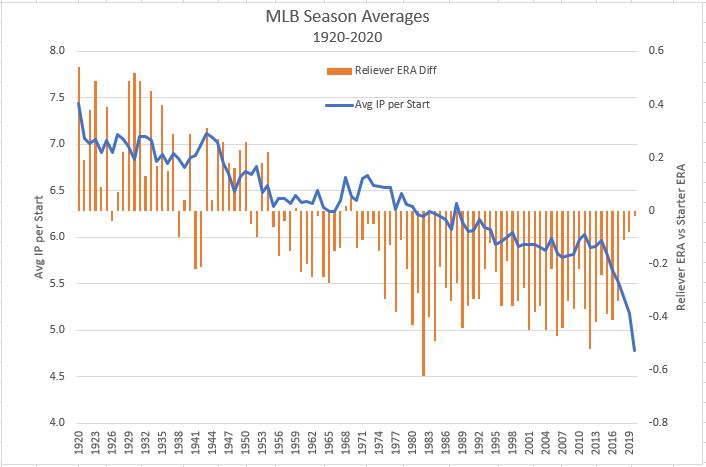
The bars in the chart are showing the difference between the ERA of starters and relievers, plotted against the right axis. A positive difference (bars above the midline) indicates that starters had better ERAs, which was the norm in baseball until about 1950. But, since then, relievers have surpassed starters in ERA (bars below the midline), and not by just a little, with advantages of one quarter of a run or more per game in most seasons since the mid-1970s. That advantage, though, has shrunk to almost nothing over the past three seasons, a trend continuing in 2021 with 4.19 ERA for starters and 4.18 for relievers at the All-Star break. Comparing relievers to starters pitching the 3rd time through the order (see chart below) preserves a bit of an advantage for the relievers but one that has also rapidly declined over the past few seasons (in 2021 at the All-Star break, starters have a 4.30 ERA the third time through the order).
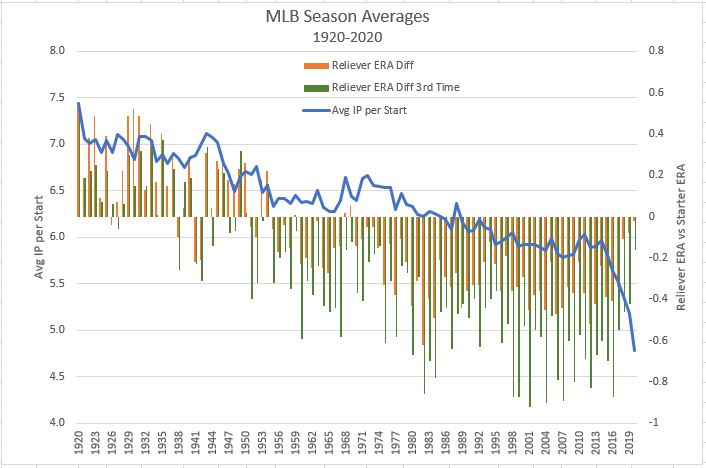
Part of the recent sudden decline in start length can be attributed to the type of pitchers making those starts. The following charts show statistics for three groups of pitchers:
- Starters: pitchers making starts in 60% or more of games
- Relievers: pitchers appearing in relief in 80% or more of games
- Swingmen: pitchers who do not meet qualification for starters or relievers
The following chart shows percentages of team games started by pitchers in these three categories.
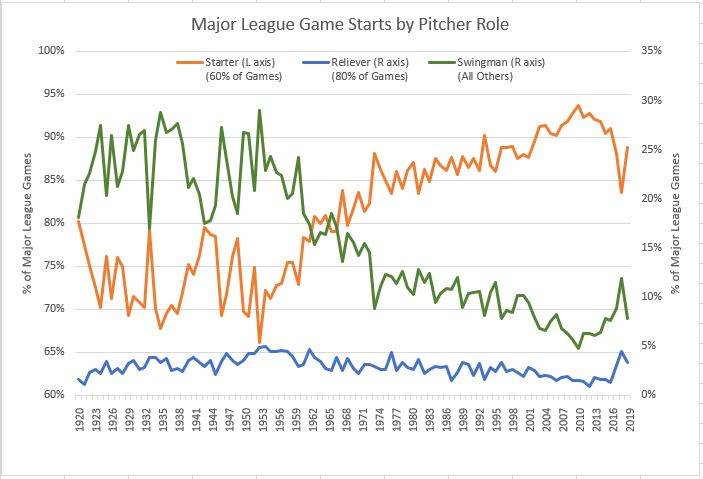
After reaching a peak in 2011 of 93.7% of games started by pitchers classified as Starters (orange line), that proportion declined to only 83.6% of games in 2019. Similarly, pitchers classified as Swingmen (green line) started a record low of 4.7% of games in 2011, then saw that number shoot up to 11.9% of games in 2019. And, starts by Relievers rose from a low of 0.9% of games in 2013 to a high of 4.4% in 2019.
Some of those increased starts by relievers and swingmen in the last few seasons were actually “opener” starts. Adjusting the average IP per start to eliminate distortion from opener starts yields results shown below.

The adjustment above is probably overdone as there were undoubtedly some starts removed that were not intended to be “opener” starts. But, this provides a rough idea of the impact of opener starts on average start length.
While starts by pitchers not classified as starting pitchers has been on the rise in recent years, that hasn’t yet altered to a large extent the underlying trend to greater specialization in pitcher roles that started in the 1960s, as shown below.
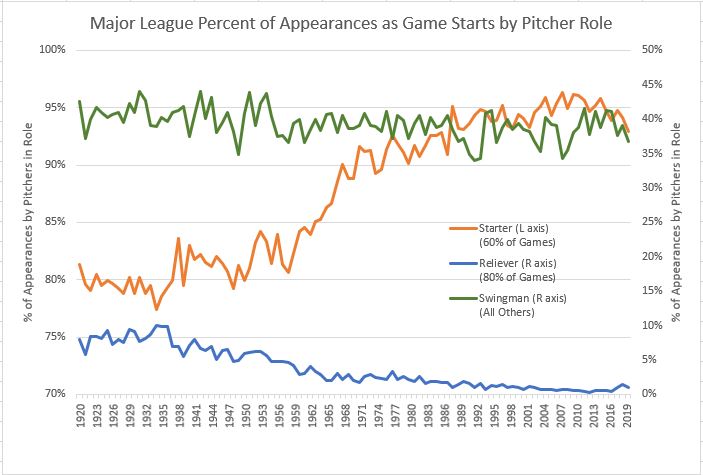
The chart above is showing the percent of appearances that were starts by pitchers in the three groups. The trends of the past several years that I’ve been discussing are most evident among Starters (orange line) where the long upward trend that started about 1960 has finally tapered off just a bit, with Starters making starts in 92.9% of their appearances in 2020, down from a peak of 96.2% in 2010. Swingmen have stayed consistently in the 35-40% range for some 70 years now, while the big move down by Relievers has much more to do with the many more appearances they now make than with their number of starts.
Looking at innings pitched by pitcher role produces these results.
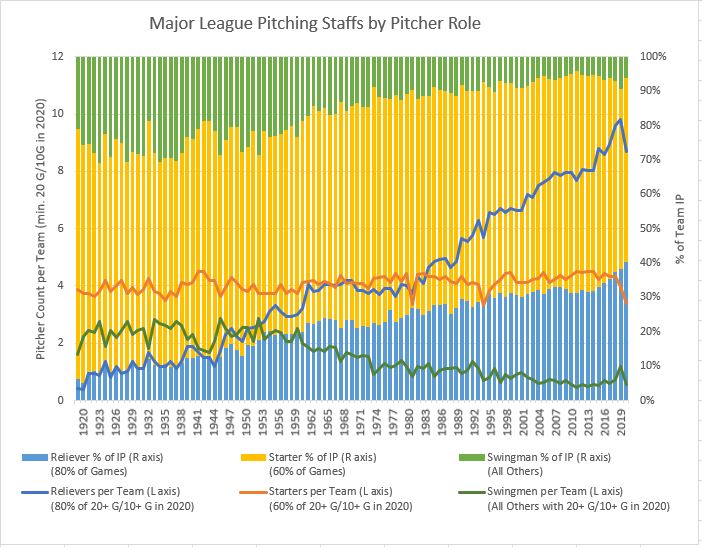
The bars show the percentage of innings pitched by pitchers in the three classifications. The biggest change, historically, is among Relievers who contributed barely 5% of innings at the dawn of the live ball era, but are now nudging the 40% threshold. Starters have seen their innings share decline from over 70% a century ago to just above 50% today, while Swingmen have ranged from highs above 30% of innings in the 1930s to lows under 5% a decade ago.
The lines in the chart show the average number of pitchers per team in each group with at least 20 appearances (10 appearances in 2020). Despite the much reduced workload by starters, teams have maintained a consistent average of about 4 Starters with 20+ appearances. In their heyday, teams employed about 2 swingmen with 20+ appearances but nowadays few teams will have more than one, and many have none. For Relievers, it’s been an almost tenfold increase in the past century, from fewer than one per team to an average today almost nudging ten.
So, what lies ahead? As we’ve seen, there is now essentially no difference in ERA between starters and relievers. Part of that is selection bias from removing starters from games before they can get too badly hurt. But, the flip side is the more innings relievers have to shoulder, the lower the bar falls on reliever performance. Still, the prospect of more diminishing returns from more use of relievers would suggest that we may be close to the bottom in terms of start length. But, how can starters go longer? Given the dollars being lavished on pitchers and the “max effort” approach employed by so many of them, it’s hard to imagine teams allowing starters to raise their pitch counts much higher than they already are. Thus, longer starts will likely happen only when pitchers become more efficient, getting more outs with fewer pitches, and that will happen only when the objective of “missing bats” starts to swing more towards “inducing soft contact”. For this observer, that can’t happen too soon.

Worth the wait! We all know the trend, but this clarifies the metrics from several perspectives: IP, and various ways of looking at staff construction and deployment. An exemplary piece of Dougish research.
“Thus, longer starts will likely happen only when pitchers become more efficient, getting more outs with fewer pitches, and that will happen only when the objective of “missing bats” starts to swing more towards “inducing soft contact”. For this observer, that can’t happen too soon.”
Doug,
Will it (longer starts) ever happen if ML hitters are emphasizing launch and exit velocity? If the batter’s approach doesn’t change, there will continue to be an awful lot of deep-count plate appearances with all the swinging and missing going on, no? We may be doomed to the stauts quo ….or worse 🙁
Anecdotally, there are some small changes starting to happen. I have definitely been seeing more “directional” hitting this year, even by power hitters, to beat the various defensive shifts.
But, even if hitters continue to swing from their heels, pitchers can help themselves to try to get earlier resolutions. Too many ABs nowadays are dominated by high and hard offerings and the breaking pitch in the dirt or way off the plate, neither of which lead to many balls in play. But, make that same breaking pitch at ankle or shin level, and the better will be more likely to chase and more likely to put in play as a weak grounder. And instead of challenging with hard stuff up in the zone, focus on changing speeds and keeping pitches just off the plate, close enough to induce a swing, and more likely to be put in play weakly because the batter’s timing has been upset. Easier said than done, of course, but certainly possible if the mindset changes from “missing bats” to “weak contact”.
I’ll second Bob Eno on this. Glad to see new material, with the customary Doug blend of erudition and accessibility.
Well, I’d love to hear others’ thoughts on Doug’s terrific research, and I still hope to, but I thought I’d mix it up on this quiet page by asking what folks think about the Cleveland Guardians name change, announced today.
When I first saw the news I was disappointed. Of all the Native American sports team names, only Cleveland’s actually had a historical anchor that softened the problem of racial prejudice: the echo of Lou Sockalexis in the choice made after Nap Lajoie departed in 1915, only 18 years after Sockalexis was briefly a Cleveland hero. I knew it had to go, but I was sorry about it, and “Guardians” seemed a very flat-footed choice (even if it retained 70% of “Indians”).
But I knew nothing. This afternoon, Clevelanders have been posting about idiot out-of-towners passing judgment in complete ignorance of the actual Guardians: heroic and really cool art-deco monoliths on a bridge near the stadium. The name seems to be full of history, gritty, and assertively local–what more could you ask (asks a fan of the Trolley Dodgers)?
Cursed Clevelander, are you lurking? Does that seem right to you?
Bob, I was wondering the same thing. I noticed that on another baseball website, the moderator decided to shut the comments off. It’s too bad that everything is political these days, but it certainly seems that way. I’m interested in Cleveland and Cleveland suburbs’ reaction to the change,
I think that the name change is an overreaction. Here’s what I found on-line about the Notre Dame sports teams’ nickname the Fighting Irish: “The most generally accepted explanation is that the press coined the nickname as a characterization of Notre Dame athletic teams, their never-say-die fighting spirit and the Irish qualities of grit, determination and tenacity”. Similar arguments could be made for the Indians. And the Braves, Chiefs, etc.
Hi Richard – It’s true that the origins of the various Native American names are often linked to ideas of bravery. One problem many see is that the honor seems tarnished by the actual conduct of the US with regard to Native Americans, a story we all know. In any case, it’s clear that maintaining the names now is a lost battle, and one that at least resulted in no human casualties. (In the case of the Indians, the Sockalexis connection–which not everyone accepts, if I recall–places the name in a different category . . . but since virtually no one now remembers that it’s not really relevant, except to dinosaurs like you and me who remember getting Indian-head nickels in everyday change.)
I’ve always assumed that the Fighting Irish were named admiringly after themselves, ND being a Catholic university long dominated by Irish priests. Looking around on the world’s most authoritative source (Wikipedia), it looks like that may be so, though the specific stories vary. (I like the one that links the name to a visit by Eamon de Valera when he was fighting to establish and lead the Irish Free State–any Dodger fan would be happy if the Fighting Irish were named after a Brooklyn boy).
Bob, Thanks for the info on the local connection to the name Guardians. Not being aware of that, my reaction was similar to yours … blah.
The question remains: do the three syllable Guardians get slurred to two (Guard-yuns) as was the case with the Ind-yuns? Or, are the the Guardians destined to be shortened to a one letter nickname, as has been the wont for the Athletics, Orioles and Mariners? The Astronauts, Metropolitans, Cardinals and Nationals at least get to keep whole syllables for their shortened nicknames, and the Diamondbacks (like their expansion cousin Devil Rays) are a hybrid, with a letter and a syllable. Every other nickname is one syllable or two.
There’s something about the question you thought of, Doug, that seems of a piece with the way you approach research. Sometimes I wonder, “Who would have thought of this angle in the first place?”
Two things come to mind. The first is that I’d never noticed the pronunciation “Ind-yuns,” though I recognize it. The Indians were actually the first team I ever rooted for (in the 1954 Series–bad choice!), and I’ve always said all three syllables, maybe to avoid “Injuns.” The second is that I believe the Astros have never been the Astronauts, even corporately, just as the late Expos were never the Expositions. Third (why stop at two when the mind keeps churning), Are the NY Metropolitans the all-time leaders in team-name syllables? I believe the correct answer is that they are tied for first with the NY Metropolitans.
Right you are, Bob, about the Astros.
Apparently, the team owner changed the franchise name because the Colt Firearms company, who had allowed the team to use its name and product image, was anticipating, correctly, big merchandise sales with the move to the Astrodome, and wanted a piece of that action. The owner (Roy Hofheinz) wasn’t interested and simply changed the team name. It was Hofheinz’s idea to go with the name Astronauts, but also his decision to shorten it to Astros as he felt sure that, if he didn’t shorten the name, the media certainly would.
Here’s an article on a previous attempt at “re-branding” of a major-league team. It wasn’t a success.
“Reaction from certain quarters was swift and harsh. Students at Johns Hopkins University in Baltimore protested that the team had usurped their good name, which had used by the college since the 1870s. Philadelphia’s adoption of the Blue Jays name was described in a petition as a “reprehensible act,” one which dishonored their school due to the Phillies’ long history of losing.” Yeahhhh. My Blue Jay ancestors had it right. It’s a usurpation!
https://images.squarespace-cdn.com/content/v1/5984890903596eaddbfc4532/1505425317530-OCVUH8BLUV3OVZTMADIU/ke17ZwdGBToddI8pDm48kBsUZzeLQXwt0ybi9J957h5Zw-zPPgdn4jUwVcJE1ZvWEtT5uBSRWt4vQZAgTJucoTqqXjS3CfNDSuuf31e0tVGeoGe8Vp5GswKDoGU00LFNlsr5Jv4RkfdkobfiWVG2ihur-lC0WofN0YB1wFg-ZW0/BLUE-JAY-NICKNAME-JUNKED.png?format=300w
Let’s hope this “Guardians” thing doesn’t catch on, either……as an old man, let me say it sounds a wee bit too ‘millennial”. Is there not a single thing more germane to the city of Cleveland than a couple of statues at the foot of a bridge? I dunno….B-R dropped the “Chief” moniker from Bender and Meyers as if it never existed. B-R is a history book of achievements AND biographies. To pretend that Hall of Famer “Chief” Bender was merely ‘Charles” Bender (beyond his birth certificate) during his professional playing days is ludicrous. But, let’s all pretend these micro-aggressions against Native Americans are tantamount to the actual genocide and rewrite history wherever possible
Hi Paul E. I posted the JHU protest because I’m an alum, and I can absolutely see us lodging it, in exactly that way. I passed it on to my old college friends as well. But there’s also a certain irony to it, as Hopkins was men-only for almost its entire first century. The world is changing, maybe faster than some people like. The 19th Amendment will be 101 next month, the Voting Rights Act (what’s left of it) is 56. We have a Native American Secretary of the Interior. The Founders would have thought this ridiculous, but then they were men of their time, and we are men of ours. Our grandchildren may see an entirely different realty.
Mike L,
I wonder if the good folks at Creighton University saw this “usurption” as “reprehensible” back in the forties? But, then again, we all know, today, that there is an entirely different reality in Baltimore than what is experienced in Omaha. Or, maybe the Jesuits just bit their lips/held their tongues while the Quakers felt a need to be heard on the matter? What’s really crazy is that, nowadays, this kind of moaning and complaining still has an even bigger audience through social media. Like they say on Keyser Quad, “The truth will set you free”.
My comments regarding Meyers and Bender should have been a separate post. For all the prejudice and bias that might existed 100+ years ago, Meyers did fare well in MVP voting during the Giants’ three year run of 1911-1913. I imagine he or Doyle was the best of McGraw’s everyday eight during this period?
My personal opinion is that we need to look at things in context, because that’s all we have. I made the reference to JHU because the Phillies-Blue Jay thing is exactly what I would have expected my fellow (pre) Alums to do, including the use of the word “reprehensible” so it made me laugh, and, yes, like they say on the Quad, the Truth will set you free”. My overall reaction to the culture wars being fought continuously in the country is largely a “why do we need this garbage–can’t people be generally decent to each other without making a hash of it?” but I think that doesn’t satisfy a lot of folks on the far parts of either side of the aisle.
You probably noticed that Chief Bender went to the same school as Jim Thorpe. I think the intensity of the racism directed towards Native Americans had peaked by then–at least baseball had not excluded them, as they did Blacks.
The last four months I’ve been researching and writing a series of pieces on the period 1775-1800. These guys (all guys) were a combination of great talents and great flaws. Four of the Five “Founder” Presidents were slave owners, and Jefferson only won in 1800 because of the Federal Ratio. Rational people neither erase them or whitewash their pasts.
The best way to right injustices is to behave better in the future.The past is what it is.
“The best way to right injustices is to behave better in the future.The past is what it is.”
Mike L.
Amen to that – definitely worthy of billboard space. I wish I would have said it first 🙂
Bill James, when explaining/rationalizing the worst of Ty Cobb’s behavior, stated something to the effect, “Cobb didn’t invent racism; he merely was taught it”…..and was, basically, a product of his environment. So, yes, we all (all men) have to be better in the future.
Thanks
I’ve heard about the Blue Jays name, but never realized before it was a sleeve patch on a “Phillies” uniform. Kind of a muddled approach. (Nice way to end the article, but it would have been kind at least to mention 1980 in passing–the one time last century the Phillies didn’t end a season as losers.)
I am, indeed, lurking.
Thoughts – hoo boy. I have a lot. But before penning a much lengthier post, I’ll keep it brief. I don’t agree with changing the name. But knowing it had to happen, Guardians was pretty high on my list – I like Spiders in theory but the baseball buff in me can’t shake that they’re not the same franchise, and that their place in baseball history is being perhaps the worst team ever.
I like the Guardians statues a lot. I think they’d make very good iconography for merchandise and logos. Which makes it all the more puzzling that they went with that awful, minor league/clip art looking winged baseball. But hey – the logo is one of the easiest things to change in the future.
To Doug’s point – I imagine it will be root root root for the Guard’yuns, two syllables. But what about the let’s go Tribe chant? Will it become let’s go Guards? We shall see.
This all makes sense to me, CC, except for the “perhaps” near the end of the first big paragraph.
Well, they’re certainly the worst from a real major league. There were some National Association teams that didn’t win a single game, but those were fly by night operations in an unstable league where an unfair concentration of the best talent was on the top teams.
CC, I think every NA team triumphed on the field at least once. But in percentage terms you’re right: there were some worse than the ’99 Spiders. The worst of them all was the 1875 Brooklyn Atlantics, perennial losers who went 2-42 for a .045 percentage, which makes the .130 Spiders look mighty. (The Brooklyn manager was the founding manager of the Cleveland team in ’71.)
However, it may be worth noting that the Spiders finished their last season with a run of 1-40, a pace of .024. I think the Spiders really deserve their outstanding reputation. (I’m not going to mention that the Atlantics finished up with a 0-31 sputter; it spoils the story.)
I hope it isn’t “Go G’s Go”.
Well, the Spiders are reasonably considered the worst single season team for their 1899 performance. But they were coming off of 7 consecutive years of better than a .500 winning record with 3 second place finishes in a 12 team league. Of course, syndicate ownership, which led to contraction to 8 teams by eliminating the teams in Baltimore, Washington and Louisville, along with Cleveland, moved all their best players to St. Louis. Cy Young you may have heard of, and several other HoFers.
You’re right, KDS: the Spiders fell into the syndicate trap when the Robison bros. decided to join forces and move the big guns to St.L.
One of the side effects of the Spiders getting stomped like that is that they became teama non grata (so to speak) in their own hometown, and after July 4 they played all but eight of their games away, which helped power them to their 20-134 rendezvous with history–when they said last farewells to Cleveland they were 19-99. The papers began referring to them not as the “Spiders” but as the “Outcasts.” (Such a great name! I wonder why there was so little clamor to bring it back this time.)
The other Blue Jays are pummeling the Red Sox tonight in their 99th game of the season, and Toronto now has three players with 75 runs scored.
Just the 10th team of the expansion era with three such players in a team’s first 100 games, following the ’61 Tigers, ’69 Reds, ’77 Reds, ’95 Angels, ’96 Rockies, ’99 Indians, ’01 Astros, ’07 Tigers and ’19 Red Sox. Some good teams there but no pennant winners. Evidently, a more balanced attack (the next Blue Jay, not counting tonight’s game, has only 42 runs) yields more wins.
Doug,
Since the Blue Jays are on pace to have three guys score 120 runs, I gotta think that trifecta probably hasn’t happened since the ’49 or ‘ 50 Red Sox? Or 1936 nyy?
Only four teams have done it since those ’36 Yankees: the ’48 Red Sox, ’96 Mariners, ’96 Indians and ’02 Yankees.
Don’t know if it will last for those guys since a lot of the run scoring is being driven by Vlad Jr hitting out of his mind…but, if he hits .320 with 50 homers, I guess he, Semien, and Bichette will all get to 120 R. If it weren;t for some DL time, George Springer probably would have been close as well
Vlad has hit a bit of a tailspin lately, with OPS down almost 300 points for second half (since ASG). His BABIP has dropped over 100 points in the same period, probably due to weaker contact more than bad luck.
However, the Blue Jays are 17-10 since the ASG and 12-4 since returning to Toronto, as Springer has picked up for Vlad in a big way.
“probably due to weaker contact more than bad luck.”
A very interesting thought, Doug. Now that launch speed data is available, wouldn’t there be a way to reduce the “luck” factor in BABIP by factoring in average contact strength? With exceptions–very few in this bunt-averse era–batting skill involves contact-strength*ball-placement. Average launch speed on BIP could substantially reveal how much “luck” is attributable to outcomes with the formula BABIP*LS (perhaps expressing LS relative to league average).
Although there are also ways to assess the success of placement beyond hit/out, given data collection on fielding play-difficulty, it would be harder to attribute that to the batter’s intent. But, except in rare cases (failed bunts-in-play, which could be excluded), maximizing contact strength is a uniform batting goal.
If I recall, teams are already doing this by prioritizing “barrel” frequency over measures like BA in player assessment.
My comment was based mainly on observation, as I see most of Toronto’s games. Guerrero normally makes very solid contact, but has been out of sorts the last two weeks or so, rolling over a number of pitches with weak grounders to the left side.
I understand, Doug. I was picking out of your comment a pet idea that you didn’t intend, related to old arguments about “luck.”
When the season ends and we look at Guerrero’s BABIP (and at any player’s), how can we know what you and others saw about those weak outs? If someone said Jr’s “luck” changed mid-season, you could correct them and say, “No, his BABIP fell off because his contact fell off, not because the ball happened to be slapped at a fielder. The problem wasn’t bad luck, it was bad execution.” But how can we quantify that and make sure you get to tell the story to everyone looking at B-R?
“Grounders” and “to the left” would be more likely to raise BABIP if they were not “weak” but strong. The lowered launch speed that goes with “weak” accounts, in part, for the bad luck of fielders getting to grounders that might have gone through at higher speeds.
Happened to notice that Shoehi Ohtani is currently leading the AL in HR and CS. If he finishes the season that way, would be first player since Ken Williams in 1922 to lead his league in those two categories.
Toronto’s Teoscar Hernandez recorded a HR, double and single in consecutive games (Aug 14-15), becoming the 119th player to do so. Hernandez joins Joe Morgan and Rickey Henderson as the only players to do that and also attempt a stolen base in each game. Of those 119 players:
Question: Baseball-reference now indicates that Lou Gehrig has hit 22 career grand slams rather than the 23 that he was originally credited with. Anyone know why?
The text of the BR article about him has it at 23: “He held the career record for grand slams – 23 – until being passed by Alex Rodriguez in 2013.”
If you go on the Advanced Stats, Home Run log drop down, there is an ROB category. Double-click and you should get “1-2-3” (runners on 1st, 2nd, 3rd) when he homered. Still indicates 23 bases loaded homers…..One of the GS’s lacks a description but RETROSHEET indicates “Combs Rolfe and Chapman scored” on July 7, 1935
Gehrig’s Event Finder indicates 22 grand slams but notes that there is missing data for the game of 7/7/1935. That’s what caused the discrepancy and 23 grand slams it is. It can be deduced from the box score that Combs, Rolfe and Chapman were indeed the base runners.
The desciption below is from RETROSHEET. I don’t have any idea why BR didn’t include it since they typically have used retrosheet boxscores (and play-by-play?) in the past:
YANKEES 5TH: Combs singled; Rolfe singled [Combs to second];
Chapman walked [Combs to third, Rolfe to second]; Gehrig homered
[Combs scored, Rolfe scored, Chapman scored]; Lazzeri out on an
unknown play; Selkirk walked; Crosetti singled [Selkirk to
second]; Jorgens grounded into a double play (shortstop to
second to first) [Crosetti out at second]; 4 R, 4 H, 0 E, 1 LOB.
Yankees 7, Senators 0.
This is a sort of guess on my part. BR did not use that Retrosheet data for their PBP because there was an unknown play. In other words BR uses Retrosheet data only when the PBP is fully known.
Richard,
What’s even more interesting is that the Tigers won the whole thing but on 7/7/1935, they were at 46-28 and finished 93-58. No great shakes thre but, The Chicago Cubs were at 40-32 and finished up 100-54. They played at a .732 pace to finish the season (60 -22). I was not aware nor had ever heard of their strong finish…. always hearing about the ’51 NY Giants (42-15 .737). Funny, but neither the ’35 Cubs nor the ’51 NYG won the WS
Just saw something very odd. Salvador Perez of the Royals has 343 total bases and all of 20 BB in his last 160 games (2020 -2021). There has never been a ML season where a player managed this same combination…not Alfonso Soriano….Joe DiMaggio (rookie) ….no one.
Dante Bichette came closest with 359 TB and 22 BB in COLO during the 1995 season. Is it safe to say, already, that his son is a better ballplayer than him?
Paul E., you made me look at Joe D. and what surprised me was that, after his Rookie year (where he had a BB rate of 3.6%) he never dipped below 8.9% after that. More fun–just 3 intentional walks in 1360 PA over his first two years. Of course, he did bat third in front of the Gehrig fellow (stats lost to antiquity).
As of today, 8/26, Adam Wainright and Yadier Molina have formed a starting battery for 298 games. The record is 324 games held by the Mickey Lolich/Bill Freehan battery. If they both play for the Cardinals next year, (Molina has just signed a 1 year contract with them), they have a good chance of breaking that record.
Nice (surprising) season by Wainwright.
Richard,
I can’t seem to find this anywhere on-line. Wander Franco, apparently, has surpassed Ken Griffey, Jr. and Roberto Alomar for the most consecutive games reaching base as a 20 year old since 1961. Do you have any idea who might hold the overall/all-time record for a 20 year old? Kaline? Mantle? Ott? Trout? Ted Williams?
Any input is greatly appreciated. – Thanks !!
The best I can do is to present a list of 20 year old players with the greatest number of games played in which they reached base. This is without reached on error.
135…..Al Kaline
134…..Mel Ott
134…..Ken Griffey Jr.
130…..Juan Soto
128…..Mickey Mantle
127…..Ty Cobb
122…..Ken Hubbs
121…..Bob Bailey
116…..Dick Hoblitzel
116…..Roberto Alomarl
Thanks Richard – I can check game logs for all these guys and might be able to figure it out unless, of course, someone who’s not on the list managed to surpass the best streak of these guys. I.E Mike Trout
Thanks again,
I found 26 for Kaline and 33 for Ott.
Paul: I got 25 for Griffey Jr. and Alomar. Let me know what you get.
Richard,
I was going half-blind trying to read this stuff on B-R with the vertical and horizontal columns crossing my eyes but, I thought 28 for Ott (6/11/29-7/4/29); 28 for Mantle (6/14/52 – 7/10/52) and two streaks of 26 for Kaline (4/12/55-5/11/55 & 5/24/55-6/22/55).
I believe the 25 for Griffey and Alomar were actually already quoted as the ‘post-1961’ records so, yes, you’re definitely correct on that.
To be honest, a friend mentioned this achievement by Franco and, with the way he took a walk and the way he hit for average, I would have guessed Ott all along.
But, honestly, I probably should double-check “my work” with all the columns etc… on the game logs
I found Ott with 33 games from 8/24 to 10/6 in 1929.
I got 28 for Mantle.
Stathead (aka P-I) says the record is 43 games for Frank Robinson. Here’s the list.
Doug
Thanks! And Robinson didn’t even make Richard’s top ten list of most times reached in an age 20 season. I guess he cooled off but still managed to hit 38 homers
Frank Robinson reached base in 111 games.
Speaking of streaks, Yankees won their 12th in a row tonight. Surprisingly (to me), it’s their longest winning streak in 60 years, since a 13 game streak in Sep 1961.
12 games is a nice streak, but not crazy long. I would have thought the Yanks, with all their success, would have topped it more recently than the Maris/Mantle duel.
Pingback: Parallel Lives – Naveed Chowdhury